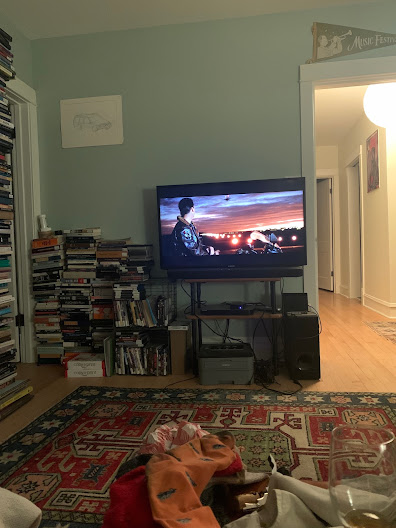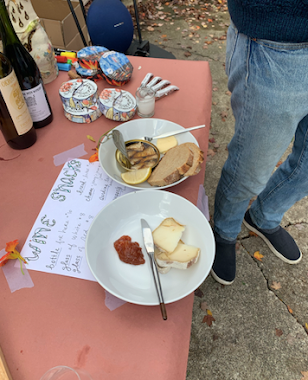This week we debuted two new packs available for delivery. One comes from the vignerons Marie and Vincent Tricot in the Auvergne in France, including their rosé of Pinot Noir and their fleshy but fresh white wine called Désiré. The other is my movie pack, two wines I recommend drinking while watching two particular films. They are generally wonderful wines, one white and one red, that don’t require any media to make sense, it’s just for fun. There’s a white wine, Le Temp Faits Tout blanc from Remi Poujol, and O Trancado from La Perdida.
I sort of thought everyone who likes wine also drinks wine while watching movies and am starting to realize it’s not the case. It has become a ritual in my house for a few reasons. If you have the right wine with the right movie it enhances everything - it makes action seem more swift, jokes funnier, monologues more profound. I think it’s the same reason a lot of people drink socially, at least according to a set of novelty cocktail napkins someone gave me once, which, rather grimly, read I drink to make the people I’m with more interesting. Yikes. You can take it too far with wine and media, if you wind up just getting too intoxicated and crying at the monologues in Pirates of the Caribbean 3, say, for instance. While I still find those moments cathartic, I feel hollow when I remember the touching line the next day, and it doesn’t have the same resonance. I recommend you always drink water, too, if drinking wine.
For me, making a movie and wine match is about energy,which is similar to pairing food and wine. You can go for contrast or complement. If the movie is playful and light, a fresh and direct wine might be good. If it’s a dark movie, like literally dark or dark in tone, you can have something deeper, dusty. You don’t want to double down too much on matching the character of the movie and the wine, however, or it can feel over the top, and you wind up falling asleep watching Underworld with a glass of old vine Sangiovese still in your hand. In that instance, I was reaching for a smell-o-vision style pairing of a sanguine wine with a vampire flick. Much like 4DX, this came up short.
I asked my husband what he considers when it’s his turn to select a wine for a movie we are watching. His concerns were a little more practical than mine. He goes for something that will last and be interesting to drink for at least the duration of the film, but also something that you can drink two glasses of and not become very drunk. For him, the wine must always be refreshing. “It’s dry work watching a movie,” he said.
I can’t summarize Top Gun better or more concisely than A.O. Scott and Manohla Darghis in their viewing club piece for the New York Times, and I won’t try.
A story of boys, toys and sunglasses, “Top Gun” was a shiny, noisy, dumb hit. When it landed in 1986, it launched Tom Cruise into the superstar stratosphere and his decades-long action-flick flight plan. Depending on your point of view, the Tony Scott-directed “Top Gun” was harmless (mindless) fun, a gung-ho commercial for the military-industrial complex, a perfect distillation of the Reagan era or — with its sweaty, bare-chested high jinks — the most delectably homoerotic movie to come out of Hollywood, maybe ever.
I was skeptical that I would enjoy Top Gun. To those of you who are also skeptical, I understand. But in March 2020 my husband and I sank into the couch with our two cats, who seemed to also be watching the movie - I had a theory they thought the planes were flies on the monitor. Or maybe like me, the cats just loved the spectacle of stunning aerial photography and non-stop synthesizer-heavy tracks. We re-watched Top Gun this week in preparation for the release of the long-awaited sequel. I went to the fridge for a pulpy, cold wine with verve, and found it in Le Temp Fait Tout.
It’s hard to talk about Remi Poujol’s wines without addressing the man himself. I’ve never met Remi but have heard many stories about what a generous and wonderful champion he is for natural winemaking. He is an advocate and a teacher, who has evolved his farming and winemaking practices alongside a community of like-minded vignerons in the neighboring area like Joe Jeffries, Julien Peyras and Bernard Bellahsen. He’s a member of Association des Vins Naturels and one of the initial five principal vignerons of the BRUTAL!!! movement. I’ve written about the star text of the vigneron previously - I think in reaching for a wine from Remi I was thinking of the powerhouse he is, in comparison to Tom Cruise, a reliable performer who has come to embody the tentpole of Hollywood action stardom.
Thinking about movie wine as refreshment, there’s nothing better to drink while watching the iconic sweaty sunset volleyball scene than Le Temp Fait Tout. It’s a leesy and uplifting white wine made mostly from the grape variety Ugni Blanc. Rainbow received this wine last year and have kept a few bottles to see how it grows and changes. We wanted it to settle a little bit, when it first arrived it seemed really quiet. It’s now a little more expressive, but, just like when it arrived, it changes quickly. I like drinking this wine that has its own sense of locomotion along with a film that is essentially about speed. Together they make for a pleasant rollercoaster ride. The brightness of the wine quenches movie thirst while the steely, stoney minerality matches the sleak machinery on display.
Ok so the second recommendation is also for something of an action movie, albeit a science fiction one - Escape from L.A. the 1996 film co-written, co-scored and directed by John Carpenter. It is the sequel to Carpenter’s Escape from New York, which he made in 1981. Both take place in a post-apocalyptic America The year is 2013, and after just one of many ongoing earthquakes, L.A has been turned into an island-prison for the entire country. You go in but you can’t get out. Kurt Russell reprises his role as Snake Plissken, a former soldier who nearly got away with robbing the Federal Reserve. If Snake is to survive his death sentence, he needs to rescue the president’s daughter from L.A. Along the way he evades many dangerous face offs with various gangs and crews, including vampiric plastic surgeons in what used to be Beverly Hills, where he has to save his own flesh from being cut up and used in their underground skin shops.
I really enjoyed drinking the remarkable wine O Trancado from winemaker Nacho Gonzalez while watching this wild film. Nacho Gonzalez is one of the most progressive natural winemakers in Galicia, Spain. He actively seeks out vineyards that are isolated and remote. O Trancado comes from an old vineyard which Nacho inherited from his grandmother, named after the area it’s planted within, and the Garnacha Tintorera & Mencía vines yield less than 1kg of fruit per plant.
As Carpenter tours us around his dystopian L.A. worlds, there are vibrant colors, lots of reds, blues and purples. It kind of feels like a carnival. I found the flavors of this wine also so vivid and rich - gleaming, juicy cherry fruit, crunchy violet and tart red currant. It’s a wild and rustic adventure of a wine, opaque and deep, a little dirty tobacco savory thing like the ash from the pyre that is this future California coast. Like Carpenter’s film, there’s a lot going on without anything seeming too distorted or too circusy, it all just comes together, even if at times they are viewed and drunken through a fun house mirror - one moment the texture seems too heavy to have without food. My suggestion is in fact to first start drinking the wine with dinner, a little piece of meat is very nice, then finishing it with the movie afterwards.
You can check out the pack in our store. Please don’t hesitate to email me with your own thoughts about movie and wine pairings, I’d love to know! Our address is Rainbowwinechi@gmail.com.








